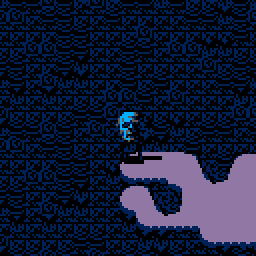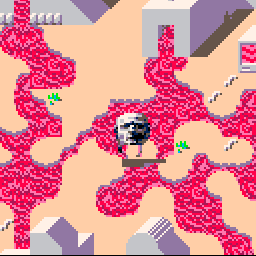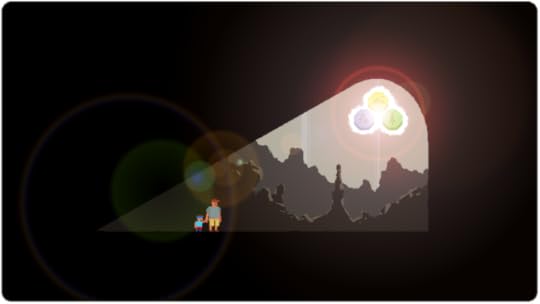Kill Screen Magazine's Blog, page 200
November 5, 2015
Videogames and '80s Hollywood Masculinity: A Love Story
Videogames are stuck in the era of Rambo.
November 4, 2015
There may still be joy to be found in racing games
I spent the first 11 years of my life reading used car listings and saving up for my first set of wheels. I spent the next four months of my life burning all of these car savings on arcade racers, a relationship that burned so bright and fast that I have never since felt the urge to learn how to drive or buy a car.
Put otherwise: The 90’s Arcade Racer speaks to the part of my heart that will forever belong in the entrance hall-cum-arcade of Montreal’s Quilles G Plus (aka: RoseBowl). As the name implies, the game, which just released a new round of images, is a collection of ‘90s car games tics: unnervingly peppy music, decals as far as the eye can see, checkpoints that make Damien Hirst look like a master of subtlety, and a collection of cars and tracks that don’t really go together. And sure, this is a long way of saying it’s all nonsense. But that, in turn, is just another way of saying that ‘90s arcade racers—and, hopefully, The 90’s Arcade Racer—are fun.
Car buffs, for all their shared interests, cannot agree on a definition of fun. One of the many dead horses Top Gear famously flogged was the stereotype of the car buff ranting ad nauseam about technical specifications. This was an unfair strawman, as almost everything in the world of Top Gear was, but it was not without hints of truth. Car culture is sufficiently broad to accommodate the wonks and the less studious, but car games have rarely achieved a similar balance. The arcade racers of the 1990s were decidedly unconcerned with reality. They had plenty of technical details, but those details existed within a fantastical universe. The pendulum swung the opposite way in later generations of car games, like the Need For Speed franchise, which were not wholly real but wore their accuracy as a badge of honour. “We went through all the technical specifications to make this absurd title,” the games seemed to scream, as if that would excuse the reset button. And games like Need For Speed were still fun, but they were also joyless.
I haven’t driven since those days
That distinction haunts the car game. If you enjoy being behind the wheel, any car game can be fun. (This, admittedly, is a hypothesis developers are all too eager to test.) But that sort of fun is different from pure joy. In a truly joyous car game, pleasures are associated with the act of driving but detached from its purely mechanical elements. This might be why Rocket League, a car game that has virtually nothing to do with how cars actually work, has been such a success. It is so vibrantly stupid that you can’t help but forget about pistons and gear ratios. These are the conditions in which a joyous car game thrives. Any car game can achieve this, but it’s much harder to get there when a game wants you to care deeply about shock absorbers.
I cannot promise you that The 90’s Arcade Racer will fulfill any of this promise. I cannot promise you that any game will, to be quite honest. But I can’t help but be hopeful that a game reminiscent of the RoseBowl (but, crucially, without the smell of steamed hot dogs) will be the one that does that trick. I haven’t driven since those days, but in the right environment I’d sure do it again.
Find out more about The '90s Arcade Racer on its Kickstarter page.
Mason Lindroth's "walking simulator" is a thing of surreal beauty
Mason Lindroth's videogames have always appealed at first look. You may extend that to 'first feel' too, given that they're usually made of squirming clay and chopped-up degenerated photos; time and again, uniquely and gloriously tactile. But let's stick with that initial love at first sight idea. In my experience, as soon as you see an image of Lindroth's latest virtual world, a desire to simply move around in it becomes deeply embedded.
This is why the disclosure that Lindroth gives ahead of his "small graphics exercise," that it is not a game as such, but a "de-facto walking simulator," doesn't lessen the excitement (as intended) but ups it. Sure, the turn-based battles in this year's Hylics were definitely entertaining, with drinks cartons spinning and imploding, and flesh being traded blow-for-blow. But the world exploration was the best time I had with that game (and with Lindroth's previous ones, too). And you're saying that this graphics exercise is all and only that? Hot damn.

Lindroth has created a lovingly compact isometric world out of pixels for us here. Understandably, it's much smaller than the larger surreal lands he usually spoils us with. But inside are plenty of Delphic symbols and dancing skulls, sphinx-mounted televisions and swirling crimson pools, pyramids and antennae. It's as if someone animated Salvador Dali's surreal deserts, those that are barren except punctuated with melting clocks and carnivalesque creatures. You are a head on legs; a stone-faced expression worthy of ancient Greek masonry, mobile, sentient, and curious.
shows you rituals and strange architecture in the distance
The question of "why?" probably won't even enter your mind given the bandwidth of sights to grok. The topography has the complexity of a hole-punched maze with a number of unavoidable dead ends. Get stuck for long enough and it'll turn to a pleasing shade of night. It's the type of place that shows you rituals and strange architecture in the distance but doesn't let you immediately explore them, teasing you forward. You eventually will be able to investigate those other places, but to do that you first need to experience what this whole project seems to have been made for: the psychedelic warping effect.

Plunge your trotting head into a television screen and its multiple colors will spill out and expand to your entire view of the world in rupturing vertical bands. It's as if you fell into the bizarre TV portals of Videodrome and then got sucked into 2001: A Space Odyssey's Star Gate sequence. In a couple of seconds, you see the bright colors of pink and yellow writhe across the landscape before going out like a candle through burnt oranges and then turning black and white. You'll see this a few times before your journey ends and restarts, each time confused as to what happened and where you ended up. And by the end of it, if you're anything like me, you'll find a single cycle isn't enough.
You can play Mason Lindroth's graphics exercise in your browser.
Videogame dadification takes a delightful turn for the bizarre in Dad Quest
IRL dads are basically super human. In fact, there's an entire subreddit dedicated to dad reflexes because they are so outside the realm of normal human capabilities that their special powers only activate once the fruit of one's loins is threatened by malicious gravity and the like. Perhaps this explains why dadification has taken over so many gaming plots: because the super-human capabilities of a dad translates seamlessly to the super-human feats achieved by most videogame protagonists.
But usually in games, the super-human capabilities of a father are explored through a very specific lens. In titles like The Last of Us and BioShock Infinite, for example, dad reflexes are used exclusively to murder and protect their adopted daughters. The father—no matter how awesome and capable—is reduced to a one-sided savior who more often than not wants to shelter the child under their wing instead of helping her become her own capable person.
Which is why Sundae Month's Dad Quest, launched on Kickstarter recently, is such a welcome surprise. A roguelite that mixes procedurally varied platforming with RPG elements, Dad Quest explores the bond between a father a child in more unexpected ways. Fathers essentially drag around their child, literally chucking them at different educational situations in order to upgrade that child "into the weapon that it was meant to be."
"every good Dad knows that an airborne Child is a happy Child."
On the legendary "Dad Island," children can't feel pain and "every good Dad knows that an airborne Child is a happy Child." After tossing the child at enough enemies, dads can even throw them through buildings in order to unlock new abilities. As the Kickstarter describes, "what happens within building walls is a mystery, but as the Child passes from one newly broken window to the next, something awakens deep inside."
Importantly, in Dad Quest, dads are more of a concept rather than the parent beholden to the male biological function. Anyone can be a dad, regardless of shape, size, and gender. Though a female playable dad isn't featured in the Kickstarter yet, she is currently in the works and is "just as Dadly as the current model."

It would seem that, finally, with Dad Quest, the concept of dadification is freed from the shackles of patriarchy. No longer are fathers supposed to be grizzly, gravely, possessive guardians. Instead, Dad Quest encourages parents to literally throw their children into situations that allow them to figure it out the world for themselves. Sure, as the parent, you can help facilitate the encounters you believe will let your child soar—you can even give your child the right tools to conquer it. But in the end, being a good parent means letting go and trusting your child. You become the biggest hero of all: a hero who admits he/she has no idea what the fuck he/she is doing, but hopes to figure it out with their protégé anyway.
And, as the Kickstarter says, even if "the Dad may not look like much," he still "knows how to pack a delicious lunch!" And doesn't that count for much more?
The aura of Twitch
How watching others play brings something new to the art of games.
November 3, 2015
Meditative Anxiety is a strange marriage of music, static, and colors
Playing it by Ear in Meditative Anxiety
Travel back in time with the 1994 Texas budget simulator
The workings of a democracy are never pretty, but in 1994 the process of governmental sausage making couldn’t even be cloaked in a sleek interface.
In the spirit of remembering those halcyon days, feast your eyes on the 1994 Texas Budget Simulator created by the Lyndon B. Johnson School of Public Affairs at the University of Texas at Austin and lovingly preserved by the Internet Archive:
The Texas Budget Simulator does exactly what the box says, which is to say it’s a gussied up actuarial table. Actually, it’s barely gussied up. This spreadsheet is only a game insofar as it will not have real-world consequences. In that respect, any government tool can become a game if you give it twenty-one years. Less charitably, these tools are games at the time when they are first introduced, but it’s too gloomy to think about them as such.
That’s economics for you.
What, exactly, is the difference between Texas Budget Simulator and a game like SimCity? Mechanically, I submit that differences between these two are few and far between. Both games are fundamentally concerned with the allocation of scarce resources to achieve goals. That’s economics for you. Texas Budget Simulator is ironically incapable of really simulating those outcomes, but the underlying idea remains the same.
The real difference, then, is all about storytelling. SimCity and its ilk are spreadsheets come to life. The bulk of their information is intra-diegetic; you learn from the story and signs within the gameworld. Texas Budget Simulator, on the other hand is entirely extra-diegetic: it tells where other games would show. Do you have a question? Here’s another readout! In the last 21 years, city-building games (or state-builders, for that matter) haven’t come all that far in terms of mechanics. The real change, as Texas Budget Simulator will remind you, has been in their storytelling strategies.
The Paris Review publishes world���s first game about a memoir about games
Traditional print publications dip into the world of game-making to review Michael W. Clune's Gamelife
We���re launching a Kickstarter & it���s awesome
The best videogame magazine ever is getting best-er.
We���re launching a Kickstarter & it���s really awesome
The best videogame magazine ever is getting best-er with your help.
Kill Screen Magazine's Blog
- Kill Screen Magazine's profile
- 4 followers



